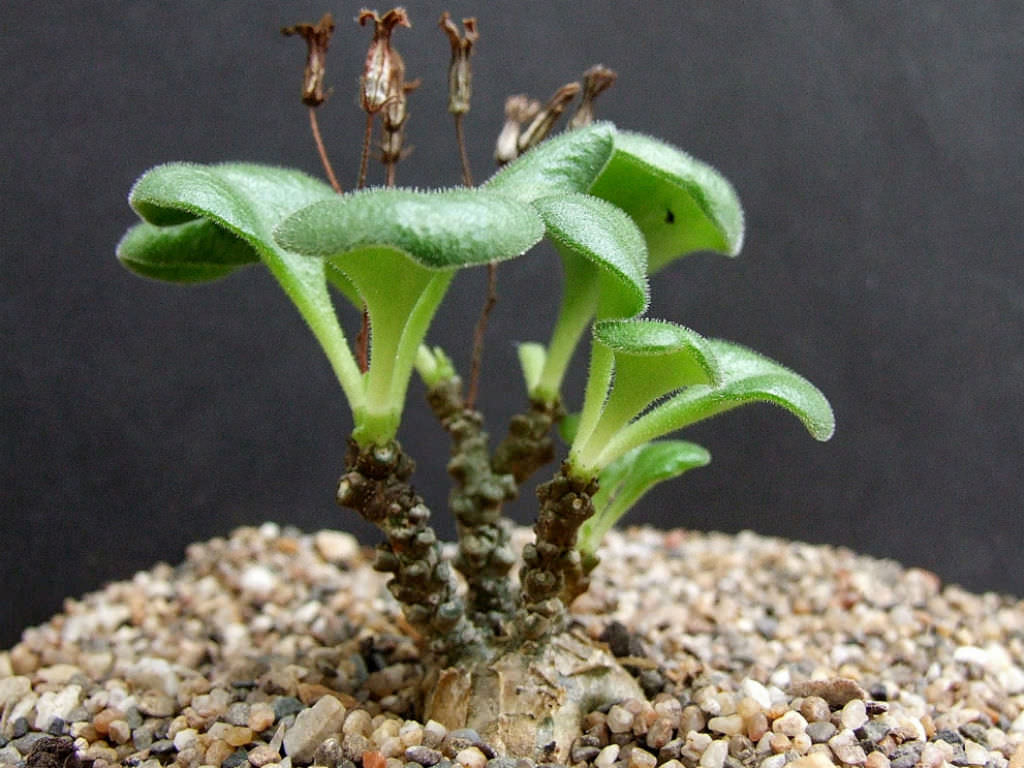Scientific Name
Tylecodon cordiformis G.Will.
Scientific Classification
Family: Crassulaceae
Subfamily: Kalanchoideae
Genus: Tylecodon
Origin
This species is native to South Africa (Northern Cape).
Description
Tylecodon cordiformis is a small, sparingly branched succulent with short branches that grow from a tuberous base with grey-brown flaking bark. The tuber is up to 2 inches (5 cm) tall and 0.8 inches (2 cm) in diameter. Branches are gray, covered with tiny hairs, up to 1.8 inches (4.5 cm) long and up to 0.3 inches (0.8 cm) in diameter. Leaves are shiny dark green, densely covered with white hairs, and clustered in terminal rosettes. They are heart-shaped, up to 0.3 inches (0.8 cm) long, up to 0.4 inches (1 cm) wide, and attached to the stem by a 0.3 inches (0.8 cm) long petiole. Flowers are tubular, up to 0.4 inches (1 cm) long, and up to 0.2 inches (0.5 cm) in diameter. They are lime-green with a covering of dense hairs and appear in summer on branched inflorescences.
Etymology
The specific epithet "cordiformis" derives from the Latin words "cordi," meaning "heart," and "forma," meaning "shape," and refers to the shape of the leaves.

How to Grow and Care for Tylecodon cordiformis
Soil: Well-draining soil mix is the key to healthy Tylecodon. Poor drainage and overwatering most commonly cause root rot in both indoor and outdoor plants.
Light: Tylecodons can survive direct sunlight exposure without any problems, but they will grow beautifully when in shadow.
Hardiness: Tylecodon cordiformis can withstand temperatures as low as 35 to 50 °F (1.7 to 10 °C), USDA hardiness zones 10b to 11b.
Watering: As winter is the growing season, Tylecodons require careful watering during the winter until the spring. Get the soil wet, and then wait until it is dry before watering again. In the summer, reduce watering to once per month.
Fertilizing: Use liquid fertilizer for cacti and other succulents during the winter months.
Repotting: You do not need to repot these plants often. You can do it when you see that the container becomes too small or shallow.
Propagation: Tylecodons can be cultivated either by seed or by cuttings.
Learn more at How to Grow and Care for Tylecodon.
Toxicity of Tylecodon cordiformis
Tylecodon species are adapted to avoid animal predation being poisonous. Therefore, keep them away from children, pets, and livestock.
Links
- Back to genus Tylecodon
- Succupedia: Browse succulents by Scientific Name, Common Name, Genus, Family, USDA Hardiness Zone, Origin, or cacti by Genus
Photo Gallery
Click on a photo to see a larger version.



